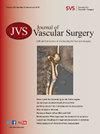复杂腹主动脉瘤开放式和血管内修复术的比较。
IF 3.9
2区 医学
Q1 PERIPHERAL VASCULAR DISEASE
引用次数: 0
摘要
目的考虑到围术期结果中已知的性别差异,比较复杂腹主动脉瘤(cAAA)的血管内(FEVAR)和开放式修复(OAR)术后男性和女性的围术期和5年结果:我们研究了血管植入监测和介入治疗结果网络(VISION)登记处 2014-2019 年间所有选择性 cAAA 修复术。我们根据性别对患者进行了分层。我们计算了分配到 OAR 或 FEVAR 的倾向分数。在估计倾向分数的模型中引入了包括年龄、种族、直径、基线合并症、近端修复范围、中心年手术量和外科医生年手术量在内的协变量。在匹配队列中,使用多变量逻辑和 Cox 回归模型对围手术期结果和 5 年结果(死亡率、再介入治疗和破裂)进行了评估:我们确定了 2825 名患者,其中 29% 为女性。在男女患者中,OAR 更为常见(OAR vs FEVAR:男性:53% vs 47%;女性:63% vs 37%)。匹配后,在男性(n=1326)中,FEVAR 的围手术期死亡率较低(FEVAR vs OAR:2.3% vs 5.1%;p结论:在男性中,与 OAR 相比,FEVAR 具有良好的围手术期预后,尽管这些优势会随着时间的推移而减弱。然而,在女性中,FEVAR 的围手术期结果与 OAR 相似,但最终会导致更高的再介入率,并可能在 5 年内导致更高的死亡率。未来的工作重点应该是确定与这些性别差异相关的因素,以改善女性 FEVAR 术后的预后。根据目前的证据,女性接受选择性 cAAA 修复术时应适当谨慎,尤其是血管内修复术。本文章由计算机程序翻译,如有差异,请以英文原文为准。
Comparison of open and endovascular repair of complex abdominal aortic aneurysms
Objective
The aim of this study was to compare perioperative and 5-year outcomes following endovascular (FEVAR) and open repair (OAR) of complex abdominal aortic aneurysms (cAAAs) in males and females separately, given the known sex-related differences in perioperative outcomes.
Methods
We studied all elective cAAA repairs between 2014 and 2019 in the Vascular Implant Surveillance and Interventional Outcomes Network (VISION) registry. We stratified patients based on sex. We calculated propensity scores for assignment to either OAR or FEVAR. Covariates including age, race, diameter, baseline comorbidities, proximal extent of repair, annual center volumes, and annual surgeon volumes were introduced into the model for estimating propensity scores. Within matched cohorts, perioperative outcomes and 5-year outcomes (mortality, reinterventions, and ruptures) were evaluated using multivariable logistic and Cox regression models.
Results
We identified 2825 patients, of whom 29% were female. Within both the sexes, OAR was more commonly performed (OAR vs FEVAR: males: 53% vs 47%; females: 63% vs 37%). After matching, among males (n = 1326), FEVAR was associated with lower perioperative mortality (FEVAR vs OAR: 2.3% vs 5.1%; P < .001). However, FEVAR was associated with comparable 5-year mortality (38% vs 28%; hazard ratio [HR], 1.2; 95% confidence interval [CI], 0.92-1.4; P = .22) and a higher hazard of 5-year reintervention (19% vs 3.7%; adjusted HR, 4.5; 95% CI, 2.6-7.6; P < .001). Among females (n = 456), FEVAR and OAR showed similar perioperative mortality (8.3% vs 7.0%; P = .73). At 5 years, FEVAR was associated with higher hazards of mortality (43% vs 32%; adjusted HR, 1.5; 95% CI, 1.03-2.2; P = .034) and reintervention (20% vs 3.0%; adjusted HR, 4.8; 95% CI, 2.1-11; P < .001) compared with OAR.
Conclusions
Among males, FEVAR was associated with favorable perioperative outcomes compared with OAR, although these advantages attenuate over time. However, among females, FEVAR was associated with similar perioperative outcomes, eventually leading to higher reinterventions and possibly higher mortality within 5 years. Future efforts should focus on determining the factors associated with these sex disparities to improve outcomes following FEVAR in females. Based on current evidence, females undergoing elective cAAA repair should be selected with due caution, especially for endovascular repair.
求助全文
通过发布文献求助,成功后即可免费获取论文全文。
去求助
来源期刊
CiteScore
7.70
自引率
18.60%
发文量
1469
审稿时长
54 days
期刊介绍:
Journal of Vascular Surgery ® aims to be the premier international journal of medical, endovascular and surgical care of vascular diseases. It is dedicated to the science and art of vascular surgery and aims to improve the management of patients with vascular diseases by publishing relevant papers that report important medical advances, test new hypotheses, and address current controversies. To acheive this goal, the Journal will publish original clinical and laboratory studies, and reports and papers that comment on the social, economic, ethical, legal, and political factors, which relate to these aims. As the official publication of The Society for Vascular Surgery, the Journal will publish, after peer review, selected papers presented at the annual meeting of this organization and affiliated vascular societies, as well as original articles from members and non-members.

 求助内容:
求助内容: 应助结果提醒方式:
应助结果提醒方式:


